HealthManagement, Volume 15 - Issue 3, 2015
Understanding Aerodynamics
The word aerodynamic has many definitions. My favourite is my own personal amalgamation of over ten different definitions that I found online: “The science of aerodynamics is the study of the resulting interactions between an object and air.” There are most certainly more advanced definitions, but to those of us who are not aeronautical engineers, no definition that I have found is clearer.
In 2004 I had a metaphorical epiphany. I realised that effective leaders and aerodynamic objects were very similar. Many of the same mechanics at work in aerodynamic objects are also at work in effective leadership. Before we can understand aerodynamic leadership, we need to understand some of the basic principles of aerodynamics first. Firstly, what makes an object aerodynamic?
Aerodynamic objects are faster, more stable, and more efficient than counterdynamic objects, according to the National Aeronautics and Space Administration (NASA) (2013). They are faster, because their shape creates less drag. More stable, since all four forces of aerodynamics, thrust, weight, lift and drag, are maintained in an equal balance. And finally aerodynamic objects are more efficient because less drag results in less strain on an engine, thereby increasing the fuel efficiency of the object, according to the website How Stuff Works (George 2015).
Aerodynamic objects have at least two characteristics that counterdynamic objects do not. They have slender cross sections (meaning they are low to the ground and not very tall), and they possess narrow leading edges (meaning the edge of the object that first makes contact with the air or water is thin and narrow). In contrast, counterdynamic objects have thick cross sections and wide, obstructive leading edges (see Figure 1).
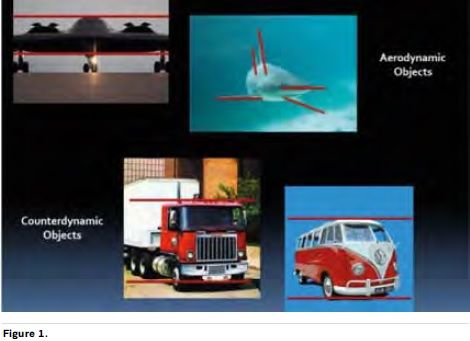
Laminar Flow vs. Turbulent Flow
Most importantly, aerodynamic objects produce laminar (streamline) flow (see Figure 2).
Laminar flow is characterised by the movement of air or fluid around or over an object in nearly straight lines, while turbulent flow is characterised by the movement of air or fluid around an object, resulting in choppy or chaotic flow (JYSCIENCE 2012). Figure 2 demonstrates that with laminar flow there is very little disruption to the airflow, because of the shape or the orientation of the object, while turbulent flow creates chaotic, choppy airflow due to the orientation of the object or the shape of its design (see FIgure 3).
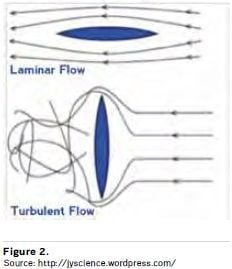
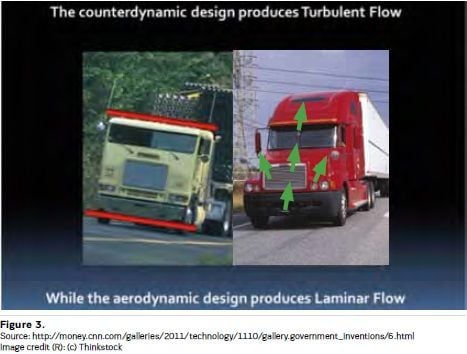
The importance of laminar flow and aerodynamic design became evident when the United States was embroiled in the energy crisis of the 1970s. President Richard Nixon requested help from all federal agencies in determining new energy solutions to ease the crisis. During this time, Daniel Lockney, a NASA engineer, who was working on the design of the top secret space shuttle, noticed that the semi-trucks that traverse the United States, consuming countless gallons of fuel, were not very aerodynamic. As an avid motorcyclist he was regularly jostled about, almost to the point of losing control of his bike, whenever a semitruck passed him on the highway (a perfect example of turbulent flow – see Figure 3). Lockney decided to bring some of the aerodynamic concepts of the space shuttle concept to modern semi-truck designs. He received permission from President Nixon to take his team of engineers out to Edwards Air Force Base to create designs for a new, more efficient semi-truck. After his team completed their research the plans were passed along to semi-truck manufacturers. It is therefore no accident that modern day semi-trucks look more like the space shuttle than the giant, clumsy shoe boxes moving inefficiently down the highway (CNN Money 2011).
But a valid argument remains: semitrucks are designed to haul huge amounts of cargo – they are not designed to travel fast. True, but every type of vehicle can benefit immensely from aerodynamic properties. The semi-truck pictured on p. 202 in Figure 4 is the Airflow BulletTruck.
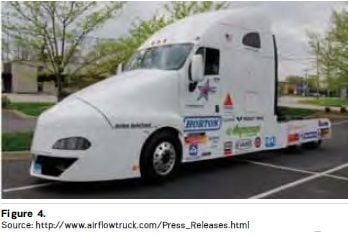
The BulletTruck has completely smooth contours, no hard edges and panels along the underside of the truck that reduce drag caused by wind colliding with the tyres. In 2012, to put the BulletTruck’s aerodynamic properties to the test, the company made a cross-country trek from Connecticut to California. The BulletTruck, with a full payload, achieved an amazing 13.4 mpg compared with 4-6 mpg with ordinary semi-trucks (Chick 2014).
The Aerodynamic Leader
To begin to tie aerodynamics with effective leadership I ask one simple question: “As a leader, what is your leadership shape?”
Aerodynamic leaders are faster, more efficient, and more stable. Aerodynamic leaders are faster in that they accomplish tasks quicker. Employees get very frustrated when tasks go untended to by their leaders. Employees want movement on their problems and fast answers to their unresolved questions. Aerodynamic leaders work smarter and more efficiently. Regarding working hard, my father used to say to me that washing machines work hard. Working hard does not guarantee success. Aerodynamic leaders position themselves to function from their strengths. Aerodynamic leaders are more stable, because they understand the immense value of consistency. Above all other leadership traits, consistency is the key to leadership success. Employees almost always know what great leaders will do next.
Aerodynamic leaders are faster, more efficient, and more stable, because they possess minimal cross sections, thin leading edges and professional characteristics that produce laminar flow. Aerodynamic leaders have minimal cross sections that promote lift. Aeroplane wings, by design, promote lift. Consequently, aerodynamic leaders, by design, seek to elevate or lift those around them. Few things are more rewarding to an aerodynamic leader than watching the success of a member of their team. Aerodynamic leaders have thin leading edges meaning they do not have to be the centre of attention. Their employees, like air across an aerodynamic shape, flow easily around them. Their presence, while firm, promotes easy interactions. Aerodynamic leaders create laminar flow by possessing vision. Their decisions are well thought out, well timed, and produce results that are easily appreciated by their organisation. Aerodynamic leaders craft important organisational decisions from a leadership perspective, but implement those decisions from an employee perspective.
The Counterdynamic Leader
In contrast to aerodynamic leaders, counterdynamic leaders are slower, less efficient, and less stable. Counterdynamic leaders are slower, because they function at a pace that hinders confidence. When tasks that normally take one day to complete start to take one week to complete, staff begin to lose confidence in their leader. Counterdynamic leaders are less efficient, because they often focus on the quantity of work instead of the quality of work. Being a results-oriented leader is a far harder task than just working long hours. Being responsible for outcomes is much more difficult than requiring constant activity. Counterdynamic leaders are less stable, because they often prefer operational and administrative prerogatives. Executive privilege can be important to successful leadership, but only on rare occasions. Staff need to see that their leader can follow his/her own rules as regularly as they are asked to.
Counterdynamic leaders are slower, less efficient and less stable, because they possess tall cross sections, thick, obstructive leading edges, and professional characteristics that create turbulent flow. Counterdynamic leaders have tall cross sections that promote drag. Their leadership style asks the question, “What advantages can my title or authority offer me?” instead of “What advantages can my title or authority offer my staff?” Counterdynamic leaders possess thick, obstructive leading edges that manifest in a need for their employees’ attention or approval. Interactions with counterdynamic leaders are more focused on themselves than on their employees. It is important to remember that it takes much more energy for an employee to approach a leader, than for a leader to approach an employee. Finally, counterdynamic leaders promote turbulent flow, because they are often not prepared. Counterdynamic leaders often shoot from the hip or try to use their charisma, personality or experience to solve problems or produce change.
Because they are not thoroughly prepared, they often stumble or fail, producing a lack of respect in their employees that further produces a type of organisational turbulent flow.
Knowing what aerodynamic and counterdynamic leaders look like, how can we function more like an aerodynamic leader? What principles can we follow that can help us to function more aerodynamically? Aerodynamic leaders, conveniently, are metaphorically similar to a wise and seasoned airline pilot. With that understanding, here are five aerodynamic leadership principles to get you started in the right direction.
Aerodynamic Leadership Principles
Aerodynamic Leadership principle #1:
Your passengers (the members of your organisation) cannot see what you see or hear what you hear.
Aerodynamic leaders should remember that they are the only ones in their organisation with a direct view ahead. Because of the position of their passengers they cannot see what is happening. Their vision is limited to the periphery while their primary view ahead is obstructed. This is very important to remember – your people, who are your customers, depend on you to compensate for their lack of vision. Additionally, your team members will not hear what you hear either. When the tower calls to redirect your flight, your passengers are not privy to that conversation. Aerodynamic leaders will communicate just enough to bring understanding.
Aerodynamic Leadership principle #2:
Be informative early
If your organisation must climb to avoid a storm or divert to a different destination due to mechanical issues, it is best known earlier than later. People are naturally controlling, which means that they are especially sensitive when they have no control. Your people need to feel that their pilot is in control so that their personal lack of control is under control. Communicating change with a good amount of lead time makes for a more rational and prepared group of passengers.
Aerodynamic Leadership principle #3:
Be economical in your speech
One of two things happens when someone uses too many words, but does not arrive at a conclusion: the hearer either tunes them out, or watches and waits for the speaker to crash and burn. When a pilot cannot get to the point quickly it makes his passengers very, very nervous. Pilots who explain themselves confidently are respected – pilots who explain themselves confidently and economically are aerodynamic!
Aerodynamic Leadership principle #4:
Know what your flight attendants know
Flight attendants are found among the passengers, not locked away in the cockpit, therefore they see what the pilot cannot. Flight attendants can best describe the mood of the passengers, see potential problems brewing, and are ideally positioned to improve their passengers’ flight experience. Aerodynamic leaders know what their flight attendants know, and as a result they know what is going on in their aircraft.
Aerodynamic Leadership principle #5:
Avoid actions that hinder your aerodynamic ability
An aerodynamic leader would never drop their flaps or landing gear at an altitude of 50,000 feet while travelling at over 500 mph. It would greatly disrupt the aerodynamic ability of the aircraft and imperil the passengers, but inappropriate words or actions by a leader effectively do the same thing. I have witnessed profanitylaced tirades by unhinged leaders aimed directly at their employees. I have stood by while a leader that I respected made devastatingly inaccurate statements simply because he did not do the necessary prep work to comment. Unfortunately, inappropriate words or actions of someone in leadership, almost always adversely affects the ones they lead.
Conclusion
After reading this article, a healthy exercise might be to ask the following questions:
• Are my leadership decisions aerodynamic or counterdynamic?
• Do my employees perceive me to be an aerodynamic vehicle or a counterdynamic vehicle?
• Do my employee satisfaction scores reflect an aerodynamic leader or a counterdynamic leader? Does my leadership create streamline flow or choppy, chaotic flow?
Whatever your current leadership shape is you now possess the knowledge to evaluate that shape and improve the aerodynamics of it!
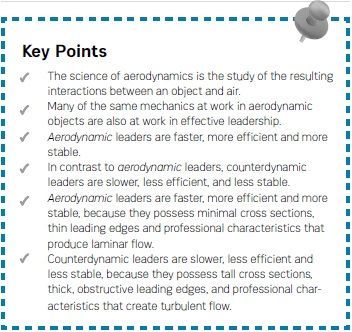
Note: the word counterdynamic is not found in the dictionary. It is a word we developed specifically for the Aerodynamic Leadership lexicon. The available antonyms for the word “aerodynamic” are, I feel, inadequate (“inefficient” (Thesaurus.com 2015), “indirect” (Synonym.com 2015), since they only speak to one or two aspects of aerodynamic principles, so this word was developed in contrast to make this discussion more easily understood


